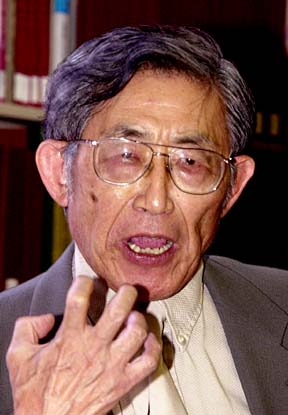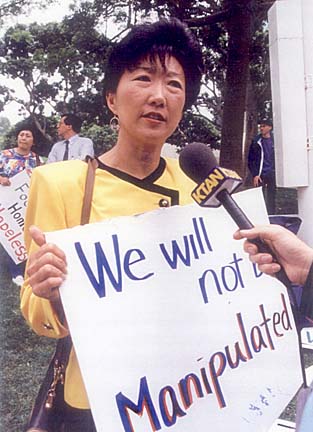
PBS
Some of the powerful images from the PBS documentary "Arirang" include Los Angeles Mayor Tom Bradley, third from right, with Korean businessmen during the renaming of the Koreatown district near downtown.
Overlooked history
Korean-American saga resumes
with new generation's struggle
When the first part of Tom Coffman's "Arirang: The Korean American Journey" -- documenting the initial wave of Korean immigration to the United States -- aired in January, he was already putting the finishing touches on Part 2, "Arirang: The Korean American Dream," which debuts 8 p.m. Thursday on PBS Hawaii. (The first segment will be repeated at 8 p.m. tomorrow on PBS Hawaii.)
"Arirang: The Korean American Dream"Airs: 8 p.m. Thursday on PBS Hawaii
Also: The first part of the two-part documentary, "Arirang: The Korean American Journey," airs at 8 p.m. tomorrow
Coffman had to make one more trip to the mainland to film a brief segment about the recent influx of Korean immigrants to parts of the old South. The story of a tailor in Huntsville, Ala., is the focus.
The tailor, and the million or so who preceded him, were largely part of a college-educated, professional work force in South Korea that arrived in the United States after 1965 determined to be independent. To start their own businesses, they sacrificed by learning new trades -- whether running stores, gas stations, dry cleaners or alteration shops -- that had nothing to do with their careers back in the old country.
Coffman has built a reputation on producing solid, thorough work, and he and his staff weave together a formidable array of resources to make a compelling statement on the overlooked history of the Koreans in America.
Before the Korean War of 1950-53, transplanted Koreans were a relatively small ethnic minority that lived almost anonymously, especially on the mainland, where they were often mistaken as being Filipino, Chinese or Japanese.
The influx of immigrants after the war took the form of war orphans adopted by Caucasian families, as well as war brides.
The brides' GI husbands probably didn't know that they were also establishing ties with Korea -- something their wives would take advantage of after 1965, when they sponsored South Korea family members' arrivals in America, thus opening up a flood of immigration. A quarter of the total immigrants in the 1970s comprised Koreans moving to large cities like Los Angeles, Chicago and New York.
PBS
Pioneering journalist K.W. Lee.
As the documentary flash-forwards to the 1990s, we find that a quarter of the Korean community is self-employed, the highest portion out of 99 U.S. ethnic groups. The estimated 4,000 Korean Christian churches around the country are also important in the acculturation process for recent immigrants.
BUT THE conscientious Korean American didn't come into being until the 1992 race riots in South Central L.A. Accusations were flying that Korean store owners were taking their profits out of the inner city.
Over three consecutive days of rioting and looting that included the city's Koreatown -- with no police presence the first two days -- the local Korean community was galvanized to protect their own, surrounding their businesses with cars and trucks, and arming themselves with shotguns.
Things appear to have been patched up between blacks, Latinos and Koreans in Los Angeles, if a segment in the documentary is any indication. We see young Korean Americans helping to advocate workers' rights for both Korean and Latino laborers. This new generation is also continuing the fight for civil rights, as with college students rallying around and defeating a racist ordinance policy concerning small businesses in Palisades Park, N.J. With their parents and families owning the bulk of those businesses, "Arirang" makes it clear that the vast Korean-American support network has come full circle, generationwise.
PBS
Activist Angela Chung.
The documentary concludes by showing Korean Americans returning to their home country to both retrace their roots and lend their American business expertise to boost the South Korean economy. The personal journeys of writers such as Hawaii resident Gary Pak and author Katie Robinson, an adoptee who is reunited with her birth father, are also briefly highlighted.
Because this second installment of "Arirang" was partly funded with local money, Hawaii pretty much gets the last word. Big Island Mayor Harry Kim makes for a success story won through his fierce independence -- a good encapsulation of the Korean-American experience.
Click for online
calendars and events.



